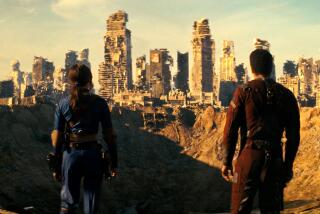‘Mad Max: Fury Road’ rules: Keep it real and really wild
For longtime fans of director George Miller’s “Mad Max” franchise, the brutal and often bizarre landscape of his reboot, “Mad Max: Fury Road,” will be both nostalgically familiar and as alien as ever.
“Fury Road” revisits the universe Miller created in his original “Mad Max” action trilogy, a desolate wasteland in which warring tribes battle for precious resources such as fuel and water. In sharp contrast to the shiny, CG-enabled visions of so many other sci-fi action films, it’s a world of the punishingly real, made up of equal parts dust, metal and blood.
With “Fury Road,” Miller was intent on investing this forbidding hellscape with a kind of savage beauty — and on doing something purely original. Even as he returned to his filmmaking roots, like one of the film’s relentless war machines tearing across the desert, his only gear was forward.
“George was terrified of repeating himself or, worse still, repeating any number of ersatz ‘Mad Max’ copies,” said the new film’s production designer, Colin Gibson. “It’s terrifying how many people have thought welding a piece of barbed wire to a Camaro equates to justifying a dystopian future.”
Stepping into the role originated by Mel Gibson, Tom Hardy plays Max Rockatansky, a haunted loner who gets swept up in a wild and deadly chase, as a group of women — led by Charlize Theron’s Imperator Furiosa — fight to escape the clutches of tyrannical desert warlord Immortan Joe (Hugh Keays-Byrne).
Bringing the franchise in to the 21st century, Miller was determined to deliver the kind of nonstop action and eye-popping visual spectacle that today’s summer moviegoers demand. But he was equally determined to adhere to the same old-school principle that has always governed the “Mad Max” universe.
“We don’t defy the laws of physics,” Miller said. “It’s the real world. It’s analog versus digital.”
In the late 1970s, when Miller — an Australian emergency-room doctor turned first-time director — set out to make a punk-rock action movie about a cop who takes on a marauding motorcycle gang, his vision of anarchic vehicular demolition had been limited by a $400,000 budget.
“The reason ‘Mad Max’ was set in the future was mainly driven by budget,” Miller said. “We couldn’t afford to shoot it in streets where you’d block the traffic, so we shot it on deserted backstreets because it didn’t cost anything — and to explain it, I just put ‘A few years from now’ at the beginning.” Presto: Instant dystopian sci-fi action movie.
Firing the engines back up on his “western on wheels” nearly 40 years later, Miller was now armed with a $150 million-plus budget that enabled him to bring to life any kind of mayhem he could imagine.
Having influenced countless action films, video games and comic books with the “Mad Max” trilogy, Miller wanted to shake off the cliches of the post-apocalyptic aesthetic.
“In games, movies and rock videos the post-apocalyptic world tends to look very junkyard-y,” he said. “I realized by observing the world that in many ways that’s not how we behave. You can go to the poorest township in Africa and see them take wire or a Coke can and fashion it into beautiful toys. As I often say, Paleolithic man with almost nothing made those extraordinary cave paintings.”
The desert landscape of Namibia, where shooting took place over eight months, had its own otherworldly beauty, which Miller heightened by hyper-saturating the color in the film to near-psychedelic vividness. “We only had teal and orange to work with, so we embraced it,” he said.
While on the surface “Fury Road” is just one long car case, Miller and co-writers Brendan McCarthy and Nico Lathouris developed detailed back stories for its various tribal subcultures. Guided by that fictional anthropology, production designer Gibson — who had earlier worked with Miller on the children’s film “Babe: Pig in the City” — set about designing Immortan Joe’s forbidding mountain fortress, the Citadel, along with a fearsome armada of heavily-armed cars and trucks.
The mandate was both simple and daunting: to create things no one had seen before. “George would fight me sometimes,” said Gibson. “I’d find a vehicle I thought had to be rust and George would say, ‘No, rust has been done. Everyone does rust.’ ”
Following the same type of process that the denizens of the “Mad Max” universe would, Gibson and his team salvaged wrecked cars and trucks to create a fleet of tricked-out war machines out of a hot rodder’s acid trip.
Ultimately some 150 different vehicles were created, 88 of which had distinct names, like Immortan Joe’s Gigahorse, made of two fused-together 1959 Cadillac Devilles, and the Doof Wagon, a truck festooned with loudspeakers on which one of Immortan Joe’s “war boys” strikes fear into foes by pounding out heavy-metal riffs on a double-necked guitar that shoots flames.
But as wild as the vehicles looked, they still needed to actually be functional at high speed without resorting to digital trickery. “As much as I applaud ‘The Fast & Furious’ movies and the wondrous success they’ve had, they do things that cars don’t do,” said Gibson. “There’s no way you can drive with two vehicles dragging 2 tons of steel on two bits of bungee cord. That kind of thing annoys me.”
To oversee the film’s elaborate stunt work, Miller called upon Guy Norris, who early in his career had worked as a stunt man on the second “Mad Max” film, 1981’s “The Road Warrior.” Drawing from Australia, New Zealand, South Africa and Europe, Norris assembled a larger team of stunt performers by far than on any previous film in the series.
“On ‘The Road Warrior,’ there were like six people on the whole stunt crew and I ended up doing the majority of the stunt work,” said Norris, who broke his leg while leaping from a motorcycle during the shooting of that film. “On ‘Fury Road,’ I had a core group of 65 stunt people, and on our biggest days we had 150.”
While Miller was insistent that the stunts in “Fury Road” be performed by real people obeying the laws of gravity, advances in technology allowed for far more extreme and death-defying daredevilry than on earlier “Mad Max” films.
“On ‘The Road Warrior,’ if I felt I could jump 5 feet, I jumped 5 feet; there were no wires or cables or any of that,” said Norris. “On this movie, we could do the best execution of a stunt you possibly could that may include rigging and wires — and then just use CG to take all that out. You could have someone leap from vehicle to vehicle and stretch the boundaries to 10 feet. We’re now in a world that I call ‘high-risk illusion.’ ”
Norris waxed nostalgic when he thought back on those months he spent in the hot, dusty Namib Desert bringing Miller’s visions to life.
“It was like we went up the river in ‘Apocalypse Now,’ ” he said. “I’d still be there — it’s just they took away the cameras and there was nothing left to crash.”
More to Read
Only good movies
Get the Indie Focus newsletter, Mark Olsen's weekly guide to the world of cinema.
You may occasionally receive promotional content from the Los Angeles Times.











